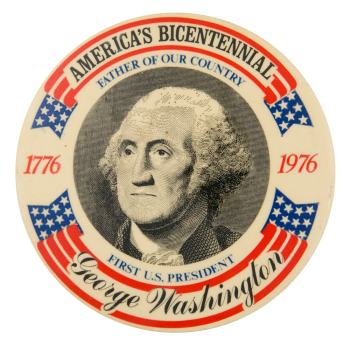| Category | |
|---|---|
| Additional Images | |
| Sub Categories | |
| Text on Button | AMERICA'S BICENTENNIAL FATEHR OF OUR COUNTRY FIRST U.S. PRESIDENT George Washington 1776 1976 |
| Image Description | Black text on red and white striped banners with blue ends with white stars over a white outer edge with red text and an illustration of George Washington in the middle. |
| Curl Text | N.G. SLATER CORP., N.Y.C. 11 union bug |
| Back Style | |
| The Shape | |
| The Size | |
| The Manufacturer | |
| Additional Information | The United States Bicentennial was a series of celebrations during the mid-1970s that paid tribute to historical events leading to the creation of the United States. The Bicentennial culminated on July 4, 1976, with the 200th anniversary of the adoption of the Declaration of Independence and was the country’s most broadly celebrated anniversary. The planning for the event began as early as 1966, when Congress established the American Revolutionary Bicentennial Commission (ARBC). In 1972, when ties between the agency and the administration of Richard Nixon came to light, many called to replace the commission leading Congress to establish the American Revolution Bicentennial Administration (ARBA) in 1973. With no grand event, the national committee focused on supporting local celebration. Communities registered their projects and, if approved, could display the official tricolored star logo that represented the bicentennial. ARBA catalogued over 66,000 events. Corporate sponsorship made possible for two American Freedom Trains containing artifacts of American History, a covered-wagon train would make stops in all fifty states. Souvenirs such as ashtrays, belt buckles and teddy bears that recited the Pledge of Allegiance were sold to commemorate the event. The national celebrations culminated during the Fourth of July weekend in 1976. Sixteen tall-masted ships traveled to New York harbor for a naval review. In Washington, D.C., participants ate from the world’s largest birthday cake. Other local celebrations held parades, rang bells, or covered water towers and fire hydrants with red, white, and blue. Bicentennial events continued after the fourth of July and even after 1976. World leaders and royalty visited the United States and gave bicentennial gifts. |
| Sources |
Veenstra, D. W. (2003). Bicentennial. In S. I. Kutler (Ed.), Dictionary of American History (3rd ed). Charles Scribner's Sons. https://link-gale-com.libaccess.sjlibrary.org/apps/doc/CX3401800430/GVR… |
| Catalog ID | EV0518 |


